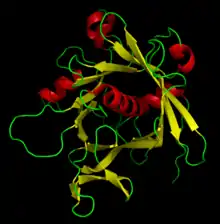| Tubby Protein | |||||||||||
|---|---|---|---|---|---|---|---|---|---|---|---|
 A tubby protein expressed in mouse brain | |||||||||||
| Identifiers | |||||||||||
| Symbol | Tub | ||||||||||
| Pfam | PF01167 | ||||||||||
| InterPro | IPR000007 | ||||||||||
| PROSITE | PDOC00923 | ||||||||||
| SCOP2 | 1c8z / SCOPe / SUPFAM | ||||||||||
| OPM superfamily | 104 | ||||||||||
| OPM protein | 1i7e | ||||||||||
| |||||||||||
The tubby protein is encoded by the TUB gene. It is an upstream cell signaling protein common to multicellular eukaryotes. The first tubby gene was identified in mice, and proteins that are homologous to tubby are known as "tubby-like proteins" (TULPs). They share a common and characteristic tertiary structure that consists of a beta barrel packed around an alpha helix in the central pore. The gene derives its name from its role in metabolism; mice with a mutated tubby gene develop delayed-onset obesity, sensorineural hearing loss, and retinal degeneration.[1][2][3]
Structure
Tubby proteins are classified as α+β proteins and have a 12-beta stranded barrel surrounding a central alpha helix. Tubby proteins can bind the small cell signaling molecule phosphatidylinositol, which is typically localized to the cell membrane. A similar structural fold to the Tubby like proteins has been identified in the Scramblase family of proteins.[4]
Function
Tubby proteins have been implicated as transcription factors[5] and as potential signaling factors coupled to G-protein activity.[6] They are associated with neuronal differentiation and development, and in mammals are implicated in three disease processes when mutated: obesity, retinal degeneration, and hearing loss.[5] In mice, mutations in tubby proteins are known to affect life span and fat storage[7] as well as carbohydrate metabolism.[8] Tubby domains associate with cytoplasmic side of cell membranes through binding of different phosphoinositides[9]
Human proteins containing this domain
External links
References
- ↑ Noben-Trauth, K.; Naggert, J. K.; North, M. A.; Nishina, P. M. (1996). "A candidate gene for the mouse mutation tubby". Nature. 380 (6574): 534–538. Bibcode:1996Natur.380..534N. doi:10.1038/380534a0. PMID 8606774. S2CID 4272027.
- ↑ Kleyn, P. W.; Fan, W.; Kovats, S. G.; Lee, J. J.; Pulido, J. C.; Wu, Y.; Berkemeier, L. R.; Misumi, D. J.; Holmgren, L.; Charlat, O.; Woolf, E. A.; Tayber, O.; Brody, T.; Shu, P.; Hawkins, F.; Kennedy, B.; Baldini, L.; Ebeling, C.; Alperin, G. D.; Deeds, J.; Lakey, N. D.; Culpepper, J.; Chen, H.; Glücksmann-Kuis, M. A.; Carlson, G. A.; Duyk, G. M.; Moore, K. J. (1996). "Identification and characterization of the mouse obesity gene tubby: a member of a novel gene family". Cell. 85 (2): 281–290. doi:10.1016/S0092-8674(00)81104-6. PMID 8612280. S2CID 15670925.
- ↑ Ohlemiller, KK; Hughes, RM; Mosinger-Ogilvie, J; Speck, JD; Grosof, DH; Silverman, MS (1995). "Cochlear and retinal degeneration in the tubby mouse". NeuroReport. 6 (6): 845–9. doi:10.1097/00001756-199504190-00005. PMID 7612867. S2CID 8311280.
- ↑ Bateman A, Finn RD, Sims PJ, Wiedmer T, Biegert A, Söding J (January 2009). "Phospholipid scramblases and Tubby-like proteins belong to a new superfamily of membrane tethered transcription factors". Bioinformatics. 25 (2): 159–62. doi:10.1093/bioinformatics/btn595. PMC 2639001. PMID 19010806.
- 1 2 Boggon, TJ; Shan, WS; Santagata, S; Myers, SC; Shapiro, L (1999). "Implication of tubby proteins as transcription factors by structure-based functional analysis". Science. 286 (5447): 2119–25. doi:10.1126/science.286.5447.2119. PMID 10591637.
- ↑ Carroll, K; Gomez, C; Shapiro, L (2004). "Tubby proteins: the plot thickens". Nat Rev Mol Cell Biol. 5 (1): 55–63. doi:10.1038/nrm1278. PMID 14708010. S2CID 7065010.
- ↑ Mukhopadhyay, A; Deplancke, B; Walhout, AJ; Tissenbaum, HA (2005). "C. elegans tubby regulates life span and fat storage by two independent mechanisms". Cell Metab. 2 (1): 35–42. doi:10.1016/j.cmet.2005.06.004. PMID 16054097.
- ↑ Wang, Y; Seburn, K; Bechtel, L; Lee, BY; Szatkiewicz, JP; Nishina, PM; Naggert, JK (2006). "Defective carbohydrate metabolism in mice homozygous for the tubby mutation". Physiol Genomics. 27 (2): 131–40. doi:10.1152/physiolgenomics.00239.2005. PMID 16849632.
- ↑ Cho, W. & Stahelin, R.V. (June 2005). "Membrane-protein interactions in cell signaling and membrane trafficking". Annual Review of Biophysics and Biomolecular Structure. 34: 119–151. doi:10.1146/annurev.biophys.33.110502.133337. PMID 15869386.